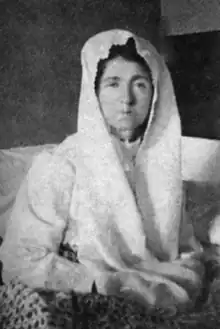Mihrengiz Kadın
Fatma Mihrengiz Kadın (Ottoman Turkish: مهرانکیز قادین, "sun's/light's daughter"; 15 October 1869 - 12 December 1938) was the third consort of Sultan Mehmed V of the Ottoman Empire.[1]
| Mihrengiz Kadın | |||||
|---|---|---|---|---|---|
 | |||||
| Born | Fatma Hanim 15 October 1869 Adapazarı or Sochi | ||||
| Died | 12 December 1938 Alexandria, Egypt | ||||
| Burial | |||||
| Spouse | Mehmed V | ||||
| Issue | Şehzade Ömer Hilmi | ||||
| |||||
| House | Ottoman (by marriage) | ||||
| Religion | Sunni Islam | ||||
Early life
Mihrengiz Kadın was born on 15 October 1869. Official records state that she was born in Adapazarı but Harun Açba believes that she was born in Sochi instead and that she had fled to the Ottoman Empire with her family during the Russo-Turkish War of 1877–1878. Her real name was Fatma. In any case, she received a good education in the palace, where she learned to play the piano.[2] Mihrengiz had a brother named Ibrahim Bey, who served as the third chamberlain to the sultan.[3]
Marriage
Mihrengiz married Mehmed as his third consort, when he had been a prince, on 4 April 1887. After Sultan Abdul Hamid II's accession to the throne in 1876, Mehmed became the crown prince, after which they settled in the crown prince's apartments located in the Dolmabahçe Palace. On 2 March 1886, she gave birth to her only child, a son, Şehzade Ömer Hilmi.[4] On 27 April 1909, after Mehmed's accession to the throne,[5] she was given the title of "Third Kadın". At the end of 1909, after death of Dürriaden Kadın, she became "Second Kadın".[1]
Safiye Ünüvar, a teacher at the Palace School, whom she met in 1915, noted in her memoirs that unlike the other wives, Mihrengiz was slim, while the others were quite heavier. This was because she had been suffering from illness from the past few years.[6][7]
On 30 May 1918, Mihrengiz met with the Empress Zita of Bourbon-Parma in the harem of Yıldız Palace, when the latter visited Istanbul with her husband Emperor Charles I of Austria.[8]
Philanthropy
In 1912, the "Hilal-i Ahmer Centre for Women" was organized within the "Ottoman Hilal-i Ahmer Association", a foundation established in 1877 to provide medical care in Istanbul and surrounding communities.[9] Mihrengiz was a member of this organization.[10]
In May 1915, Mihrengiz visited the soldiers at the Haydarpasha Hospital together with some other women from the imperial harem. During her visit she also addressed the soldiers:
How are you, my soldier sons, my soldier brothers! What do you wish for? We are all at your service! If I knew how to bandage your wounds, I would pay great attention and devotion to you and circle around your head end like a capable nurse. You are very precious to us.[11]
Last years and death
After Mehmed's death, she settled with her son. At the exile of the imperial family in March 1924, Mihrengiz, her son, Ömer Hilmi and his two children, Emine Mukbile Sultan, and Şehzade Mahmud Namık, settled firstly in Beirut, Lebanon, then in Nice, France,[12] and finally settling in Alexandria, Egypt, where Ömer Hilmi died in 1935.[4] She died on 12 December 1938 at Alexandria at the age of sixty-nine, having outliving her son by three years. She was buried in the mausoleum of Khedive Tewfik Pasha in Cairo.[1]
Issue
| Name | Birth | Death | Notes |
|---|---|---|---|
| Şehzade Ömer Hilmi | 2 March 1886[4][1] | 6 April 1935[4] | married five times, and had issue, one son and one daughter |
References
- Uluçay 2011, p. 260.
- M. Metin Hülagü (2008). Yurtsuz İmparator: Vahdeddin : İngiliz gizli belgelerinde Vahdeddin ve Osmanlı hanedanı. Timaş. p. 351. ISBN 978-975-263-690-3.
- Toplumsal tarih. Türkiye Ekonomik ve Toplumsal Tarih Vakfı. 2003. p. 10.
- Brookes 2010, p. 287.
- Faroqhi, Suraiya (2008). The Cambridge History of Turkey. Cambridge University Press. p. 79. ISBN 978-0-521-62096-3.
- Brookes 2010, p. 208.
- Sakaoğlu 2008, p. 702.
- Açba, Leyla (2004). Bir Çerkes prensesinin harem hatıraları. L & M. p. 56. ISBN 978-9-756-49131-7.
- Hacker, Barton; Vining, Margaret (August 17, 2012). A Companion to Women's Military History. BRILL. p. 199. ISBN 978-9-004-21217-6.
- Ahmet Zeki İzgöer; Ramazan Tuğ (2013). Padişahın himayesinde Osmanlı Kızılay Cemiyeti 1911-1913 yıllığı. Türkiye Kızılayı Derneği. p. 49. ISBN 978-605-5599-14-0.
- Os, Nicolina Anna Norberta Maria van (2013-10-31). Feminism, Philanthropy and Patriotism: Female Associational Life in the Ottoman Empire. Leiden University Institute for Area Studies (LIAS), Faculty of Humanities, Leiden University. p. 438.
- Vâsıb, Ali; Osmanoğlu, Osman Selaheddin (2004). Bir şehzadenin hâtırâtı: vatan ve menfâda gördüklerim ve işittiklerim. YKY. pp. 204, 210, 224. ISBN 978-9-750-80878-4.
Sources
- Uluçay, M. Çağatay (2011). Padişahların kadınları ve kızları. Ötüken. ISBN 978-9-754-37840-5.
- Sakaoğlu, Necdet (2008). Bu Mülkün Kadın Sultanları: Vâlide Sultanlar, Hâtunlar, Hasekiler, Kandınefendiler, Sultanefendiler. Oğlak Yayıncılık. ISBN 978-6-051-71079-2.
- Brookes, Douglas Scott (2010). The Concubine, the Princess, and the Teacher: Voices from the Ottoman Harem. University of Texas Press. ISBN 978-0-292-78335-5.
.svg.png.webp)